#rusty schweickart
Text

Apollo 9 astronaut Rusty Schweickart walks in space, March 6, 1969.
2K notes
·
View notes
Text
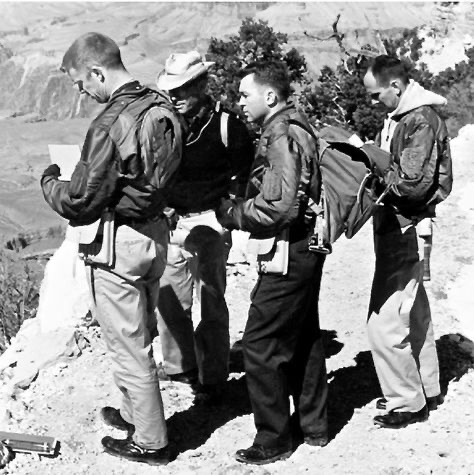
(Credit to the owner)
3 notes
·
View notes
Text

Stepping out on the front porch. Astronaut David Scott opens the hatch to check out the view during Apollo 9, March 1969. In this pic taken by fellow astronaut Rusty Schweickart, ‘Gumdrop’, the Command Service Module is docked with ‘Spider’, the Lunar Module. A9 was the 1st flight incorporating all Apollo spacecraft components. The 10 day mission was the 2nd launched by a Saturn V rocket.
#apollo 9#spacecraft#command module#low earth orbit#astronaut#space travel#1969#earth orbit#astronauts#space exploration#vintage space#space#space age#nasa#moon landing#space race#spaceflight#nasa astronauts#nasa photos#space history#spacesuits#1960s
366 notes
·
View notes
Text

Apollo 9 astronauts Rusty Schweickart, Dave Scott and Jim McDivitt in front of their Saturn V Rocket. Their mission (March 3–13, 1969) was the third human spaceflight in the Apollo program. Unlike the missions before and after them, they did not leave Earth orbit and go to the moon. But it was important because it was the first test of a complete Apollo spacecraft (command and service module, lunar module and the Saturn rocket). During the mission, the crew tested the LEM and successfully performed a rendezvous and docking with the command module. The results of this mission proved the lunar module and landing craft were ready to go to the Moon on Apollo 10.
The excellent Tom Hanks/Ron Howard miniseries From the Earth to the Moon has a great episode that showcases Apollo 9 called "Spider" - the title comes from the nickname the astronauts gave the lunar lander. The show of course features the mission but does a superb job showing the numerous challenges the Grumman engineers had in designing, building and testing the lander.
40 notes
·
View notes
Text
Tbh the reason why I tend to refer to astronauts with like their nicknames is bc I’ve spent the last two and a half months obsessively learning about them and in a lot of their own words and their colleagues’ words they will be called by nicknames so I end up just picking it up but also like a lot of their nicknames were their preferred names anyway. Like Gus Grissom never went by Virgil he always went by Gus. His friends knew him as Gus. So he’s Gus. Rusty Schweickart goes by Rusty so I’m calling him Rusty. Buzz Aldrin’s real name is Edwin. No one on earth knows him as Edwin.
4 notes
·
View notes
Text
Space history...
Apollo 9 was a test mission in earth orbit of the spacecraft and equipment that would take NASA astronauts to the moon.
One of the activities planned was to rehearse transfer from the LM to the CSM via EVA, should it not be possible to use the tunnel between the two docked module. Here is how it was supposed to be done...

However, LM pilot Rusty Schweickart fell ill with space-adaptation syndrome and it was deemed too risky to attempt the transfer. Schweickart was cleared for an abbreviated EVA on the LM front porch in "golden slippers" foot restraints to test the Apollo EVA spacesuit and backpack.

Here, he's photographed by mission commander Jim McDivitt from inside the LM.
The scales etched into the LM window would be used on future missions to show the commander flying the LM where the computer intended to land.
2 notes
·
View notes
Text
International Asteroid Day - 30 June
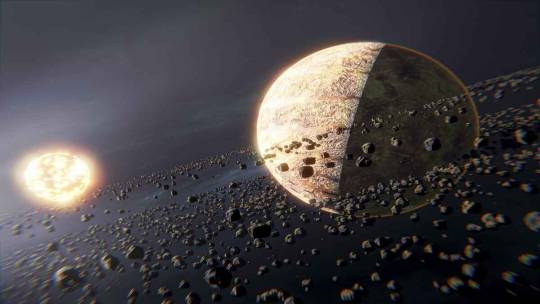
International Asteroid Day is celebrated every year on June 30th. It is an international campaign to raise awareness about asteroids. The marks the threat asteroids pose to Earth, and how to better protect our planet. This day brings together millions of people from all walks of life to recognize the danger that asteroids may bring.
The day highlights the importance of ongoing research and development to protect the planet from asteroid strikes. The day is held in honor of the Tunguska explosion, which occurred on June 30, 1908. An asteroid entered Earth's atmosphere above Siberia and exploded. The incident leveled thousands of square miles of forest and killed hundreds of animals.
Since then, understanding the dangers of asteroid strikes has become paramount in the effort to protect Earth's inhabitants. On Asteroid Day the B612 Foundation and other organizations commit and coordinate to protect the world from asteroid impacts.
Celebration Events
The celebration includes live events, panels, interviews, and even special events dedicated to Asteroid Day. These include lectures by distinguished experts in the fields of asteroid science, engineering, and hazard mitigation efforts. The world joins forces to learn more about this serious threat to our planet. International Asteroid Day stands out as an important reminder of the need to prepare for any potential danger.
There are many ways to celebrate the International Asteroid Day. These include public lectures, educational activities, and interactive displays. We can engage the public in an effort to make them aware of the potential hazard of asteroids. We should also create opportunities for experts to discuss ideas and collaborate on projects to further our understanding of asteroids.
This could include working together on virtual reality simulations and launching satellites to monitor near-Earth objects. The other way is creating educational and research materials to share with the global public. By making International Asteroid Day an annual event, we can help break down the barriers to entry for space exploration. This can help inspire the next generation of thinkers and innovators.
Let's make Asteroid Day a global celebration of exploration and inspire the world to take action!
1. History
Asteroid Day has been a global celebration for many years. First proposed in 2014 by international space scientists, including Apollo 9 Astronaut Rusty Schweickart, it reminds the threat of asteroids. These cosmic objects are remnants of the Solar System's formation and offer a unique view of the universe's power. On Asteroid Day, people join together to explore and celebrate these ancient relics.
Educational workshops, interactive games, and other events are held worldwide to share the awe-inspiring stories of our cosmic past. As technology advances, Global Asteroid Day will continue to unite the world in recognition of the universe's wonders.
2. Impact
The potential impact of International Asteroid Day, a global celebration is surely commendable. In collaboration between the United Nations, European Space Agency, and the Planetary Society, this event educates the public on topics related to asteroids. The day also highlights their potential to impact Earth, and the space industry’s efforts to detect and study them.
International Asteroid Day is an amazing opportunity to increase awareness about space exploration. The day creates an awareness of various ways in which asteroids can affect our lives. With the support of leading astronomers, engineers, scientists, philanthropists, and organizations, this event enlightens about discovery and exploration.
In the words of Planetary Society CEO Bill Nye, “Asteroid Day is a global event that celebrates the role asteroids have played in the formation of our Solar System and the critical role they continue to play in the exploration of our universe.” This is a perfect opportunity to learn more about the universe. We need to stay informed about our universe’s natural resources, such as asteroids.
The event has support from a variety of organizations, including the International Astronomical Union, NASA, and the Royal Astronomical Society. With such an impressive roster of supporters, International Asteroid Day looks like an impressive event. It has the potential to further our understanding and appreciation of the impact of asteroids on our universe.
3. Education
Asteroid Day is quickly becoming a worldwide celebration of space exploration. Every June 30th, we observe the day to educate the public on the significance of understanding asteroids. Its mission is to build global recognition of the potential impact of asteroid strikes and the requirement for space exploration.
With lectures, films, interactive activities, educational programs, and community events, it aims to encourage the world to learn about asteroids. Education is a big part of this mission. International Asteroid Day offers a range of activities and resources to engage and teach people of all ages.
With the correct motivation, this day can become a global event. The day can unite people of all backgrounds to celebrate space exploration and the importance of conquering its unknowns.
4. Events
Celebrate Asteroid Day on June 30th and join people from around the world in recognizing the importance of asteroid exploration. From conferences to art exhibitions, events will be held in cities across the globe, including those in asteroid belt regions.
Speakers from NASA, ESA, and other space exploration organizations will present on the state of interplanetary exploration, with astronomers, planetary scientists, and space industry experts on hand to answer questions and share insights. This is a chance to discover more about asteroid exploration - both now and in the future.
Come be part of history in the making!
5. Advantages
Asteroid Day is gaining traction worldwide as a celebration of space exploration. With increased awareness and appreciation of asteroids, we can unlock the potential for a new era of space exploration, bringing immense benefits.
From inviting the public to attend lectures, demonstrations, and hands-on activities for Asteroid Day, to inspiring a new generation of scientists, engineers, and entrepreneurs to explore beyond, the educational benefits are immense.
Learning the basics of science to understand the complexities of our Solar System is just the beginning. Let's make Asteroid Day a global commemoration of exploration and ensure its legacy continues to bring a better understanding of the universe.
6. Challenges
International Asteroid Day reminds us of the challenges we face in protecting our planet from the catastrophic effects of rogue asteroids. Estimates suggest more than one million asteroids travel near Earth, some close enough to cause atmospheric disturbances or damage.
But, the odds of an asteroid strike are low. Ensuring the preparation for an emergency, Asteroid Day is the perfect time to make everyone aware of the latest asteroid safety tips. Let's make it a worldwide celebration of space exploration and a reminder that we're all in this together!
7. Initiatives
Asteroid Day, taking place on June 30th is a worldwide celebration of exploration and education about asteroids - the most plentiful and possibly oldest objects in our Solar System. A passionate group of scientists, educators, and media makers have worked hard to make asteroid exploration a global priority.
Initiatives are being taken to ensure the success of Asteroid Day worldwide, such as a Global Observatory Network to map asteroids in our Solar System, a Global Educator Network to train and educate the next generation of scientists, and a Global Media Network to spread the message and create a long-lasting impact.
The goal is to make Asteroid Day a global celebration and ensure everyone understands the importance of asteroid exploration. Make Asteroid Day Global and join the celebration!
8. Participation
Asteroids are often overlooked, yet Asteroid Day is here to change that. Every June 30th, people of all backgrounds come together to explore space and appreciate asteroids. Participation is open to all, from experienced scientists to students. You can join online conversations, host an event, or access resources from the website.
Now's the time to plan how to celebrate! With Asteroid Day, everyone has the chance to make a meaningful contribution to space exploration. Let's come together to make this a global celebration of exploration.
In Short
International Asteroid Day is an annual global awareness campaign. It raises attention to the potential hazard of asteroid impacts and the need of conducting research to protect our planet from them. It is celebrated every year on June 30th, the anniversary of the Tunguska impact of 1908, a powerful airburst that leveled over 2,000 km2 of forest in Siberia, Russia.
This event is a unique opportunity to engage the public in conversations about the risks posed by near-Earth objects, the technological and scientific advances needed to protect us, and the potential of asteroid mining for resources and space exploration. We must not forget that asteroids are a fact of life in our solar system and that it is our responsibility to protect our planet from them.
International Asteroid Day is a reminder of the importance of the work researchers and engineers around the world do. They identify and track these objects, and provide the public with the necessary knowledge and support to reduce the risk of asteroid impacts. As a global community, we must continue to work together to ensure our safety and security from potential asteroid threats.
Image by Freepik
Read the full article
0 notes
Text
0 notes
Text
Remastered Apollo mission photos are simply out of this world
https://sciencespies.com/space/remastered-apollo-mission-photos-are-simply-out-of-this-world/
Remastered Apollo mission photos are simply out of this world
Half a century after the last person walked on the moon, original footage has been digitally overhauled to show NASA’s lunar missions in a new light
Space
7 September 2022
By Gege Li
NASA/JSC/ASU/Andy Saunders
THESE are the Apollo lunar missions like you have never seen them before. Taken from the new book Apollo Remastered by Andy Saunders, these illuminating images have been produced by enhancing original material to reveal new details of NASA’s forays in the 1960s and 70s.
Its programme is best known for putting the first humans on the moon in 1969 during the Apollo 11 mission, though it comprised 14 missions in total that covered everything from testing technology to collecting lunar samples. Saunders, who specialises in NASA digital restoration, created the new high-definition images from scans of 35,000 or so originals preserved in a frozen vault in Houston.
youtube
The moon’s cratered surface is laid bare in the panoramic top picture, taken during the Apollo 16 mission in 1972 and showing astronaut Charlie Duke, the youngest person to walk on the lunar surface at the age of 36.
Advertisement
NASA/JSC/ASU/Andy Saunders
The image above shows NASA astronaut Rusty Schweickart during the Apollo 9 mission in 1969, with the Apollo spacecraft and Earth reflected in his visor.
The below image shows cue cards made by Apollo 8 astronaut Bill Anders to document the upcoming mission of testing the spacecraft in the moon’s orbit.
NASA/JSC/ASU/Andy Saunders
And below is a shot of Apollo 9 commander James McDivitt performing the first docking (or joining) of two crewed spacecraft. Saunders writes that this is the only photo of an Apollo astronaut in their full suit and bubble helmet during flight. The reflections of Earth, and the docking window, can be seen on McDivitt’s helmet.
NASA/JSC/ASU/Andy Saunders
Article amended on 8 September 2022
We have corrected who is being shown in the image of the Apollo 9 mission in 1969, and the name of Bill Anders
More on these topics:
#Space
#2022 Science News#9-2022 Science News#acts of science#Earth Environment#earth science#Environment and Nature#everyday items#Nature Science#New#News Science Spies#Our Nature#planetary science#production line#sci_evergreen1#Science#Science Channel#science documentary#Science News#Science Spies#Science Spies News#September 2022 Science News#Space Physics & Nature#Space Science#Space
0 notes
Text
Bidding farewell to an unsung legend

R.I.P. James A. McDivitt, test pilot and astronaut. He passed away on October 13 and somehow it flew utterly beneath my radar.
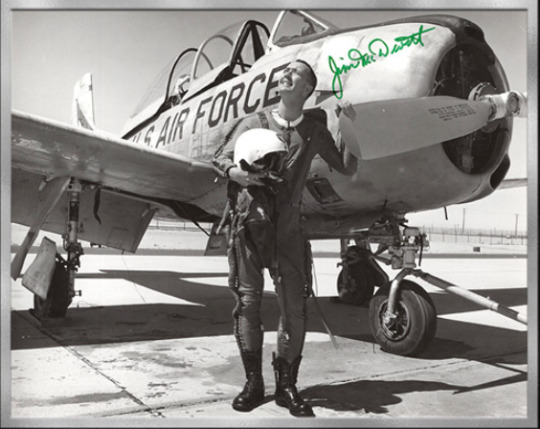
Jim McDivitt was a Korean War combat pilot, and earned a Bachelors in Aeronautical Engineering from University of Michigan, a spot in the USAF Experimental Flight Test Pilot School, and was a member of the inaugural class at the Aerospace Research Pilot School. He had over 2,000 hours in jets (here he is striking a heroic pose with a decidedly not-heroic T-28).

Later Jim was selected as a member of NASA Group 2, known as “the New (or Next) Nine.” They were chosen to augment the Original Seven for the Gemini program and beyond. From lower left, they are Jim Lovell*, Elliot See, Ed White, Neil Armstrong**, Frank Borman*, John Young**, Tom Stafford*, Pete Conrad**, and that's Jim McDivitt front and center.
(*) Six of this group went to the Moon and three (**) of them walked on it; two more died in tragic accidents before getting their chance to go. None of them were Jim McDivitt, so his career is often overlooked.

Thanks to a thing called “the pecking order,” the Mercury Seven were automatically first in line when it came to getting the mission assignments, but with the two-man Gemini program starting up, that meant Chief Astronaut Deke Slayton could assign some of these new guys to fill the right seat while the Mercury veterans commanded the mission. John Young was the first guy from Group 2 to fly, paired with America's second man in space Gus Grissom, for the first crewed Gemini mission: a simple (well, as simple as anything related to spaceflight can be, that is) shakedown flight called Gemini 3.
But Gemini 4 (June 1965) was much more ambitious, and McDivitt was given command, making him the first rookie to command a crew.
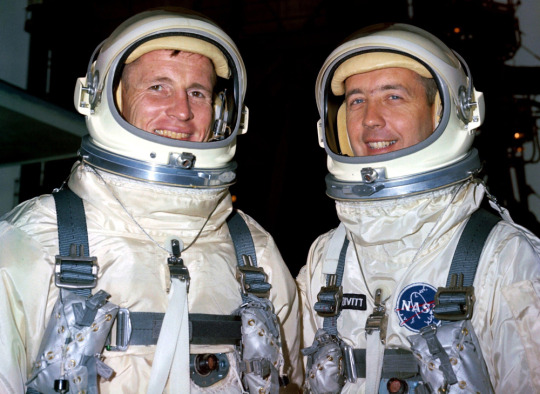
Flying right seat (left, in this photo) was his fellow Group 2 buddy and former University of Michigan schoolmate Ed White. The mission plan was packed; it was going to be four days long— longer than all of America's previous spaceflights put together. They were going to practice celestial navigation with a sextant and attempt a rendezvous with a spent rocket stage. And thanks to cosmonaut Alexei Leonov having become the first man to leave his spacecraft while in orbit earlier that year, a spacewalk was hurriedly added to Gemini 4, too.
This task fell to White, as of course McDivitt would be responsible for flying the spacecraft.

McDivitt's pictures of White during his extravehicular activity (EVA) are among some of the most spectacular in all of NASA's history.
BTW the so-called controversy of Ed White becoming too enamored of the void of space to come back into the spacecraft is bullshit. The comms setup was that the guy outside could only hear the guy inside, not the ground, and they kept stepping on each others’ transmissions.

Next up for Jim would be command of Apollo 8, the first crewed test of the Apollo Lunar Module (LM) in Earth orbit. Along for the ride were Group 3 astronauts Dave Scott, a veteran of Gemini 8, as command module pilot (CMP), and rookie Rusty Schweickart, as LMP.
Apollo 7 (Wally Schirra, Walt Cunningham, Donn Eisele) had successfully tested the CM in Earth orbit in October of 1968. But just as the Soviets had changed the Gemini 4 mission with Leonov's spacewalk, they changed the remaining Apollo schedule with their Zond spacecraft, which was capable of flying around the moon and back. They had one ready to launch, and if successful, they could say “We got there first; that means we won the space race. Ешьте дерьмо, неудачники!” And Apollo 8’s LM was nowhere near ready to fly.
So Deke and the higher-ups at NASA decided to send Apollo 8 to the moon first, by itself, without the LM. Deke didn't want to lose Jim’s crew’s experience with their lander, so he swapped them with the crew of Apollo 9: Frank Borman, Jim Lovell, and Bill Anders, who went on to spend Christmas 1968 in lunar orbit (famously reading from Genesis on Christmas Day).
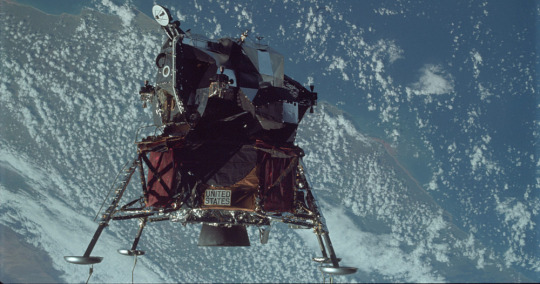
In March of 1969 the CM Gumdrop (Dave Scott thought it looked like a piece of candy when it arrived at the Cape wrapped in cellophane) and LM Spider (well, just look at it!) were launched and tested thoroughly in Earth orbit. When Jim and Rusty flew off in Spider they became the first men to fly a spacecraft which could not land if things went wrong (weight was such an issue that the cabin walls were made of layers so thin that if you dropped a screwdriver it would puncture them, and of course it had no heat shield to get through Earth's atmosphere).
The crew put Spider through its paces; firing the descent engine several times, testing its ability to maneuver with the thrusters, and firing the ascent engine to get back to Dave in Gumdrop. Rusty also did a modified spacewalk to test the lunar EVA suit (sadly, he was spacesick at the beginning of the mission and as a result, never got to fly again).
After retiring from active flight status, Jim served as NASA’s Spacecraft Program Manager for a few years and retired from the Air Force in 1972 with the rank of Brigadier General; he also earned a buttload of Flying Medals, Distinguished Service Medals, and other honors throughout the course of his life.

Jim, Dave, and Rusty reunited in 2019 for the flight's 50th anniversary. With Jim’s passing, the Apollo 8 crew is the last Apollo crew still intact.
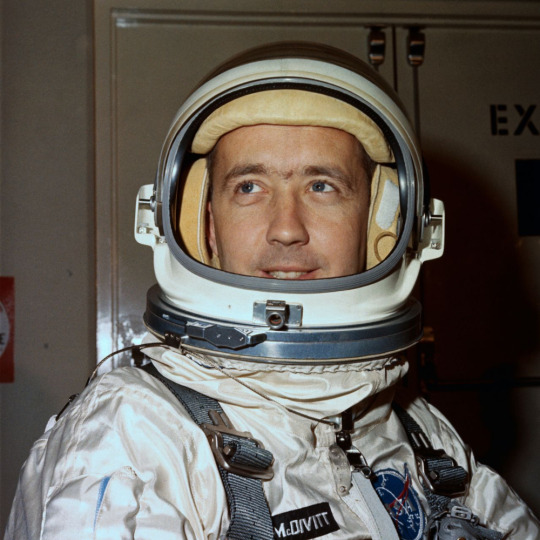
Ad Astra, Jim: June 10 1929 - October 14, 2022
1 note
·
View note
Text
From Moon Maids to Astronauts: How Feminists Transformed the Space Race
Protests taking place inside NASA’s Mission Control were only the tip of the iceberg.
— Chasing The Moon | Article | By Neil M. Maher
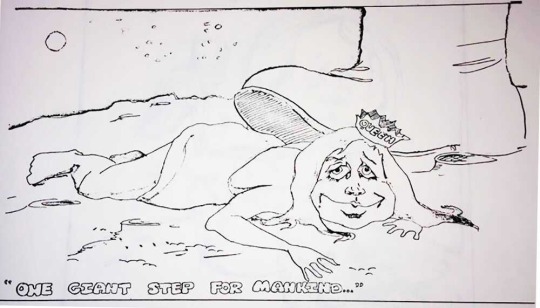
Queen: “One Giant Step For Mankind…”
"The Rise and Fall of Lunar Royalty," which American Experience has republished from the January 1974Texas Monthly, describes a remarkable protest that took place during the preceding summer inside NASA’s Johnson Space Center. A group of female workers became alarmed when the center announced it was holding a beauty pageant for the July 1973 Lunar Landing Festival in nearby downtown Houston. The concerned women snuck into the center at night and secretly replaced the original ballots, which listed 48 female employees, with fakes listing forty-five men, including the center’s director Chris Kraft and astronauts Rusty Schweickart, Pete Conrad and Deke Slayton. After the fake ballots were distributed the following day through the interoffice mail, the women snuck back into the center and taped a list of “winners” from their alternative pageant to every bulletin board and elevator bay in the complex. Feminist Gloria Steinem was listed as the write-in favorite.

He’ll Give Her The Moon: “Just About As High As She Can Go!”
The protestors also taped dozens of hand-drawn cartoons alongside their fake ballots. In “He’ll Giver Her Tha Moon,” a bathing-suited “Miss Moon Maid” standing on a “Height of Equality” pedestal suggested not only that women at NASA were judged according to their good looks and bodily figure but also that the space agency considered them only “3/4” equal to men. The cartoon’s caption, which read “Just About as High as She Can Go,” reaffirmed the perception of this glass ceiling at NASA.
Two additional cartoons placed the beauty queen on the lunar surface. In “One Giant Step For Mankind . . .” (seen above) Neil Armstrong’s boot steps on the back of the festival’s “queen,” while “Moon Maid” depicts a female astronaut holding a broom, mop, and trash can above the tag line “You’ve Come A Long Way Baby . . .” The message in these cartoons was loud and clear: the only way for women to get to the moon was as maids or doormats

Moon Maid: “You’ve Come A Long Way Baby…”
Such protests taking place inside NASA’s Mission Control were merely the tip of the iceberg. During the early 1970s, second wave feminists from across the country held dozens of demonstrations protesting gender discrimination within NASA’s hiring practices as well as the space agency’s all-male astronaut corps. The National Organization for Women (NOW) spearheaded such activism, which included letter-writing campaigns to Congress, lobbying of NASA administrators, picketing outside the space agency’s Washington, D.C. headquarters and even feature-length exposés on the possibilities of female astronauts in Gloria Steinem’s Ms. magazine. NOW even placed NASA’s top administrator, James Fletcher, on its FBI’s Ten Most Wanted list. In this case, however, NOW’s “FBI” stood for “Feminist Bureau of Investigation.”
This activism by feminists eventually paid off when on June 18, 1983 Sally Ride became the first American woman to travel in space. One of NASA’s VIP guests for the launch was none other than Gloria Steinem. “Millions and millions of little girls,” Steinem explained after watching Ride soar into the sky high above Cape Canaveral, now understand that they, too, “can be astronauts, heroes and explorers and scientists.”
— Neil M. Maher is a History Professor at the New Jersey Institute of Technology and Rutgers University at Newark, where he teaches environmental and political history. He has written about the Johnson Space Center’s beauty pageant in his most recent, award-winning book, Apollo in the Age of Aquarius (Harvard University Press, 2017).
1 note
·
View note
Text

Roger, Jim and Rusty visting the USS Kamehameha at Cape Canaveral in early 1966.
20 notes
·
View notes
Text

(Credit to NASA)
4 notes
·
View notes
Text

The view ain’t all that bad. Apollo 9 astronaut David Scott takes it all in in this epic photograph by crewmate Rusty Schweickart, March 1969. The 10-day mission commanded by James McDivitt saw the first crewed flight of the Lunar Module.
#apollo 9#astronauts#nasa#space travel#the earth#astronaut#space exploration#vintage space#space age#apollo program#historic#space#space race#nasa astronauts#nasa photos#nasa picture of the day#space program#1960s#1969#outer space
208 notes
·
View notes
Text


The Apollo 1 prime and backup crews reviewing flight plans during a weekend in California, I believe early January 1967.
#anyway. I love them 😭#gus grissom#ed white#roger chaffee#apollo 1#dave scott#rusty schweickart#jim mcdivitt#astronauts#NASA#1960s#*#the way Gus has like. shoulders. and hands. and hairy arms. I appreciate that 💕💕💕
76 notes
·
View notes
Text
See part of the reason why I’ve watched so many documentaries and am on now a third book about the space program is because I know there are so many insane different personalities at work here that everyone’s experience is different (and obvs the experience of the 400,000 others who worked to get the astronauts off the ground is also vastly different) and so like you see like, minor celebrity career military man John Glenn skyrocket to major celebrity after orbiting the earth and then quitting NASA to become a politician alongside like, Al Bean who didn’t even get to fly until Apollo reportedly bc some people at NASA didn’t like his artistic side and then after being the fourth person to walk on the moon he left NASA to become an artist full time. You’ve got Buzz Aldrin who thought he was always right and has always been a piece of shit and a staunch republican alongside Rusty Schweickart who was as close to a hippy as they’d let an astronaut get.
That’s part of what makes this shit so interesting to me. Even though a lot of these guys had similar resumés being military men and test pilots, their vastly different upbringings and eventual careers beyond the space program is absolutely fascinating.
2 notes
·
View notes